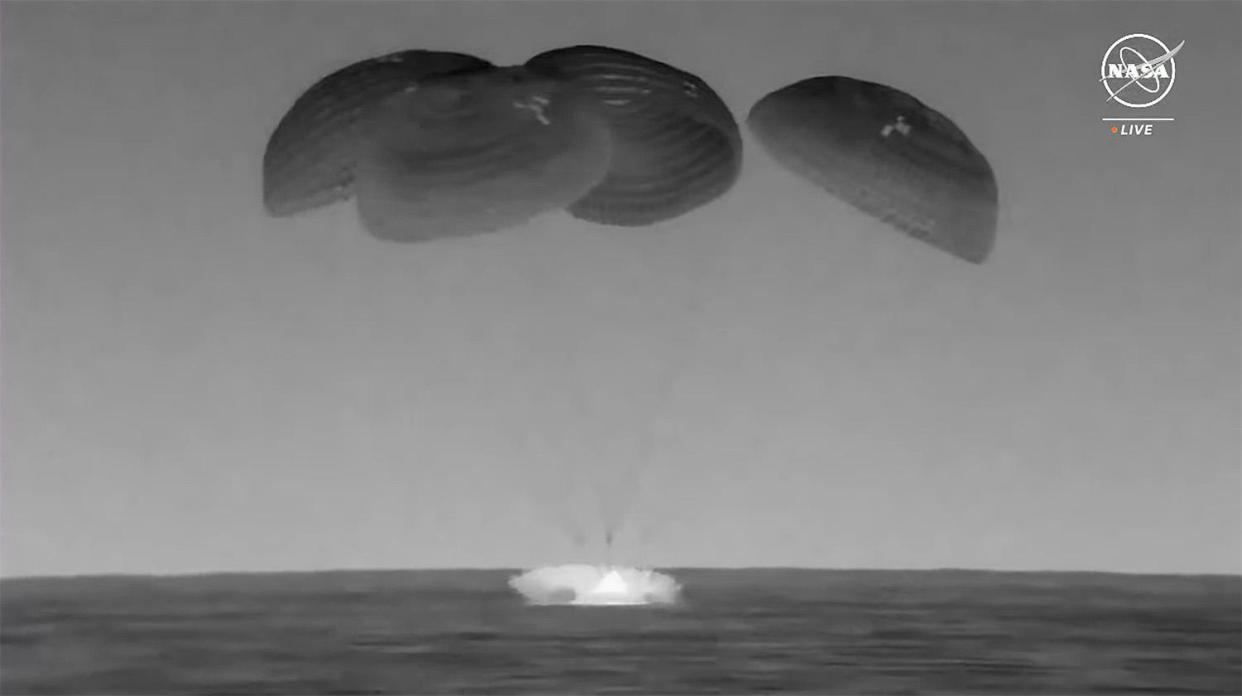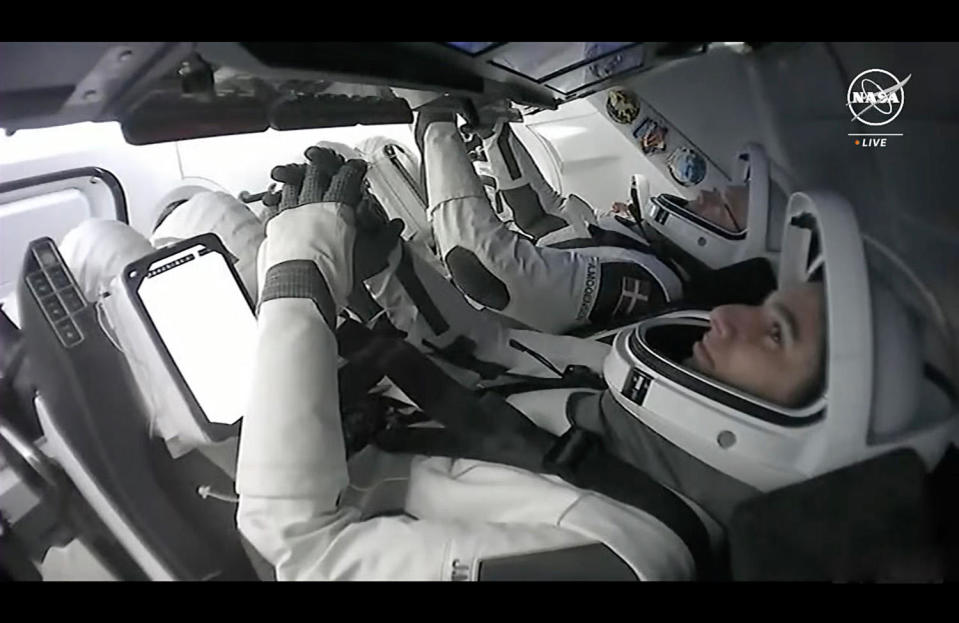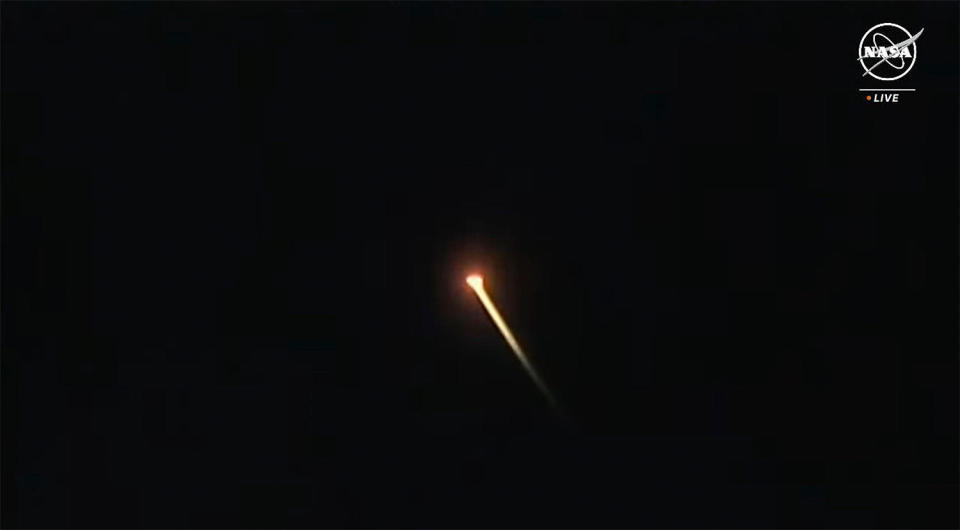4 station crew members safely return to Earth after 199-day mission

- Oops!Something went wrong.Please try again later.
- Oops!Something went wrong.Please try again later.
- Oops!Something went wrong.Please try again later.
- Oops!Something went wrong.Please try again later.
- Oops!Something went wrong.Please try again later.
Closing out a six-month stay at the International Space Station, a three-man, one-woman crew plunged back to Earth early Tuesday, streaking across the heartland of America like a blazing meteor as their Crew Dragon capsule descended to a Gulf of Mexico splashdown.
Suspended beneath four huge parachutes, the Crew Dragon "Endurance" settled to a gentle walking pace touchdown south of Pensacola, Florida, at 5:47 a.m. EDT, closing out a 199-day mission spanning 3,184 orbits and 84.4 million miles.
A SpaceX team stationed nearby hauled the capsule and its crew — commander Jasmin Moghbeli, European Space Agency astronaut Andreas Mogensen, Japanese flyer Satoshi Furukawa and cosmonaut Konstantin Borisov — onto the aft deck of the company's recovery ship Megan and promptly opened the side hatch.
Fifty minutes after splashdown, the astronauts were carried out one by one and placed on stretchers before being rolled inside for initial medical checks as they began re-adapting to gravity after six-and-a-half months in weightlessness. The stretchers were normal for returning long-duration station flyer and all four appeared healthy and in good spirits.
The 18-and-a-half-hour trip home began Monday when Moghbeli and her Crew 7 colleagues undocked from the International Space Station.
Flying 260 miles above the Indian Ocean, the crew monitored an automated 13.5-minute thruster firing starting at 4:56 a.m. EDT, slowing the spacecraft by about 212 mph and dropping the far side of its orbit deep into the atmosphere as required for a descent to the Gulf of Mexico.

Re-entering the discernible atmosphere, the Crew Dragon followed a northwest-to-southeast trajectory across the United States, rapidly slowing in a fireball of super-heated air.
Viewers along a path stretching from Nebraska to central Kansas, northeast Oklahoma, central Arkansas and Mississippi had a chance to see the returning spacecraft as it streaked back to Earth.
After crossing the panhandle of Florida, now flying at just a few hundred miles per hour, small drogue parachutes inflated to stabilize the spacecraft followed by the four main chutes. The Crew Dragon then descended to a gentle splashdown in calm winds and mild seas.
As with all Crew Dragon returns, the crew was expected to be flown to shore by helicopter, boarding a waiting NASA aircraft for a flight back to the Johnson Space Center in Houston.
Left behind aboard the space station were their replacements, Crew 8 commander Matthew Dominick, co-pilot Michael Barratt, Jeanette Epps and cosmonaut Alexander Grebenkin along with Soyuz crewmates Oleg Kononenko, Nikolai Chub and NASA astronaut Loral O'Hara.
Launched last September aboard the Soyuz MS-24/70S ferry ship, Kononenko and Chub are midway through a yearlong mission while O'Hara is wrapping up a more typical six-month tour of duty.
On March 21, the Soyuz MS-25/71S spacecraft will be delivered to the space station by cosmonaut Oleg Novitskiy, Belarus guest cosmonaut Marina Vasilevskaya and NASA astronaut Tracy Dyson. Novitskiy, Vasilevskaya and O'Hara will return to Earth April 2 using the same Soyuz that carried Kononenko, Chub and O'Hara to the station last year.
Kononenko, Chub and Dyson will use the Soyuz delivered by Novitskiy for their trip home in September.
During a change-of-command ceremony Sunday, Mogensen, the outgoing commander of Expedition 70, turned the station over to Kononenko, who now holds the record for most cumulative time spent in space over his four missions. As of Tuesday, his cumulative time in space stood at 916 days.

During a change-of-command ceremony Sunday, Mogensen, the outgoing commander of Expedition 70, turned the station over to Kononenko, who now holds the record for most cumulative time spent in space over his four missions. As of Tuesday, his cumulative time in space stood at 916 days.
"On my first mission in 2015, I had the pleasure of flying with Gennady Padalka, who at that time set the (multi-flight endurance) record for 878 days in space," Mogensen said during the ceremony.
"You've now surpassed that," he said to Kononenko, "and you are well on your way to reaching 1,000 days in space, which is an incredible achievement. There is no one more experienced than you when it comes to the International Space Station. So I'll be leaving it in probably the best hands possible."
Kononenko will reach the 1,000-day mark on June 4. By the time he returns to Earth, he'll have spent more than three years in space.
Two pilots fall asleep while flying plane with more than 150 on board in Indonesia
Watch: Rep. Schiff has testy exchange with Robert Hur over Biden classified documents probe
Watch: Rep. Matt Gaetz questions Robert Hur over Biden classified documents probe

